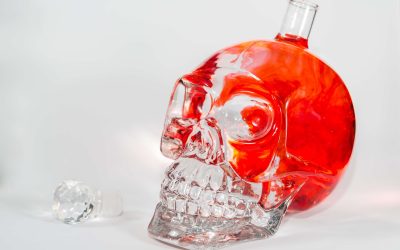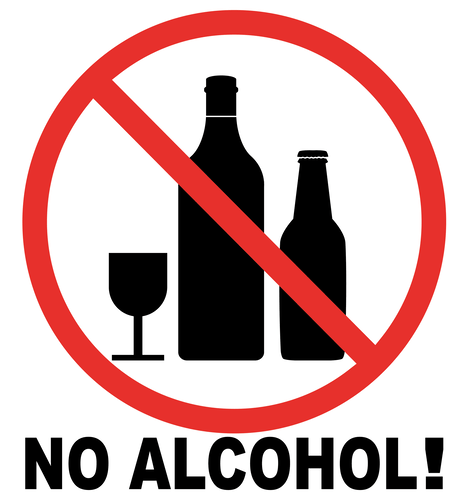
To date, there are three medications approved by both the European Medicines Agency (EMA) and the Food and Drug Administration (FDA) for the treatment of alcohol dependence; disulfiram, naltrexone and acamprosate. More recently, the EMA granted authorization also for nalmefene, a compound intended for the reduction of alcohol consumption in adults with alcohol dependence (EMA 2012). Details regarding the mechanism of action of these compounds are outside the scope of this review. In brief, the pharmacological profile is established for disulfiram (an aldehydedehydrogenase inhibitor), naltrexone (an opioid receptor antagonist) and nalmefene (an opioid receptor modulator), whereas the mechanism of action of the anti‐alcohol relapse drug acamprosate is not fully understood. An indirect activation of mesolimbic dopamine via accumbal glycine receptors and ventral tegmental nicotinic acetylcholine receptors (nAChRs) appears likely [2, 3], but additional targets has been suggested (for review see [4]). Finally, the clinical efficacy of these agents is limited [5], possibly due to the heterogeneous nature of the disorder and the complex neurochemical mechanisms underlying alcohol dependence.

Behavioral tasks
In this interview conducted at Pittcon 2024 in San Diego, Maria Marco discusses her research on the health benefits, safety, and waste reduction potential of fermented foods, and the microbial processes involved in their production. If you drink for long periods of time, it can cause depression, and when you abruptly stop drinking, it can cause anxiety,” says Dr. Anand. While alcohol is a relaxant and can make you feel good at first, chronic alcohol use can cause mental health issues. In addition to dementia, long-term alcohol use can lead to other memory disorders like Korsakoff syndrome or Wernicke’s encephalopathy. But as you drink more — and you don’t need to drink that much more — eventually, the enzymes that break down the alcohol get saturated. So, the alcohol builds up quite quickly,” explains addiction psychiatrist Akhil Anand, MD.
Absence of CSS effect on transcriptome expression of ventral tegmental DA neurons
However, the activation was described as only partial due to the lack of alteration alcohol had on levels of MHC-II or TNF-α expression. Conversely, microglial activation and neurodegeneration were clearly shown in rats exposed to intermittent alcohol treatment [91]. Indeed two-photon microscopy has been used to demonstrate the rapid response of microglia to even single acute alcohol exposure [92].
- It all began in 2013 with a challenge called “Dry January,” during which participants took a month-long break from drinking following boozy holiday gatherings and rowdy New Year’s Eve parties.
- The burst-responses should not really be seen as travelling from the unconditioned rewards and punishers to their predictors; rather, the process of burst-firing develops anew in response to predictors that involve a Hebbian mechanism [42, 43].
- A block containing the caudate and putamen was microdissected from the left hemisphere and sectioned with a VT1200S (Leica, Buffalo Grove, IL) in a sucrose cutting solution aerated with 95% O2/5% CO2 (see Supplementary Materials for composition).
- If you take just a sip of beer, and moments later—before you’ve had close to enough alcohol to get intoxicated, perhaps even before the beer has hit your stomach—feel a distinctly pleasurable sensation, it might not be strictly due to subtle aromas that result from the beverage’s blend of malt, hops and yeast.
- Individuals who scored higher in trait impulsivity measures exhibited greater choice impulsivity than their lower trait impulsive counterparts [115].
- For the McGill study, researchers recruited 26 healthy social drinkers (18 men, 8 women), 18 to 30 years of age.
All types of alcohol appear to raise blood pressure
For the determination of dopamine transient uptake kinetics, the modeling module in DEMON was used as previously described [30]. Briefly, the dopamine affinity for the transporter (Km; set to 0.16 µM) was held constant and the dopamine peak height was determined empirically for each file and used for determination of Vmax (dopamine uptake rate), which was altered to best fit the empirically obtained dopamine transients. To examine D2/3 dopamine autoreceptor function, the D2/3 dopamine receptor agonist, quinpirole (30 nM), was bath applied for 30 min and was followed by application of the D2-like dopamine receptor antagonist sulpiride (2 µM) for 15 min. To examine differences between tonic and phasic release, we applied stimuli at varying frequencies before and after the application of the β2 subunit-containing nAChR antagonist, dihydro-β-erythroidine hydrobromide (DHβE; 1 µM).
P/T depletion effects on frontolimbic FC
To address these concerns and provide opportunities for improved patient outcomes there is a movement towards “harm reduction” by many addiction specialists. A study released on August 2, 2013 found that those who are energized by alcohol have a hyperactive dopamine response to alcohol and are genetically predisposed to drink more heavily. But, in modern life, we live in a world of abundance rather than scarcity, and Lembke says our brains weren’t evolved for the “fire hose of dopamine” of sugar, social media, TV, sex, drugs or any number of dopamine-triggering stimuli so easily available. “To mitigate some of the effects of alcohol and prevent or lessen your hangovers, it’s recommended to limit your alcohol intake, drink water in between drinks, and try to eat foods with a high fat content to decrease alcohol absorption,” guides Dr. Krel. The initial euphoric effects of alcohol are a result of dopamine being released from the reward center in the brain. The impaired judgment you have when drinking alcohol may cause you to think that you can still drive, regardless of your BAC.
Pain and reward circuits antagonistically modulate alcohol expectancy to regulate drinking
Self-administered doses of amphetamine [71] or cocaine [72] elevate dopamine levels over four-fold. Dopamine antagonists at high doses block amphetamine and cocaine self-administration [86, 95, 96]. At low doses the antagonists cause compensatory increases in responding, suggesting that the rewarding effects of the stimulants has been attenuated [86, 95, 96]. Dopamine-selective lesions cause immediate loss of cocaine self-administration when the lesions are complete [97] and temporary loss when they are incomplete [98]. These lesioned animals continue to lever-press for the direct dopamine agonist, apomorphine, following these lesions, confirming that the lesioned animals remember their training history and have normal motor capacity [97, 98].

The mechanisms underlying this dysregulation of dopamine transmission are not well understood, particularly in a primate brain. Therefore, in the current study, we used fast-scan cyclic voltammetry (FSCV) to study dopamine release dynamics in striatal slices from long-term alcohol drinking and control rhesus macaques. This method allows for examination of dopamine release and its regulation on a subsecond time scale that has seldom been used in NHPs [18,19,20,21,22,23,24]. Furthermore, FSCV allows for the study of dopamine uptake using Michaelis–Menten based kinetic modeling of uptake parameters, allowing researchers to assess dopamine transporter function. Finally, we can pharmacologically probe the contribution of different regulatory systems, including the D2 dopamine autoreceptor and nicotinic acetylcholine receptor (nAChR), to dopamine release. In the DRLM test, a novel tone DS signals that an operant response at a feeder port will result in sucrose reinforcement.

Level 6: The role of posttranslational modifications
- The dopamine deficiency hypothesis is supported by a study showing decreased dopamine receptor gene expression after several months of voluntary alcohol drinking [103].
- Another area requiring further research relates to individual differences in resilience and susceptibility to AUD.
- Operant conditioning began at FR 1,1,1,1,1, with a maximum of 120 s allowed per trial, and 60 s allowed for passing through the tunnel and collecting and eating the 2 pellets.
- The absence of a DS to signal operant completion precludes direct comparison with the REV test on whether reduced operant motivation co-occurred with attenuated NAc DA release to a discrete DS.
At the 6‐month follow‐up, 79% of the patients on clozapine were in remission from a diagnosis of alcohol dependence, while approximately 33% of those not taking clozapine were in remission [148]. We are a community of more than 103,000 authors and editors from 3,291 institutions spanning 160 countries, including Nobel Prize winners and some of the world’s alcohol dopamine most-cited researchers. Publishing on IntechOpen allows authors to earn citations and find new collaborators, meaning more people see your work not only from your own field of study, but from other related fields too. Some experiments found no difference in DA release in the NAc after intraperitoneal injection of ethanol between P and NP rats.
- Instead it has been suggested that OSU6162 produces functionally opposite effects by acting as an antagonist at both presynaptic autoreceptors and postsynaptic D2 receptors [189, 193–195].
- At the beginning of the study in 1985, all of the participants were healthy and none were dependent on alcohol.
- Transcription factors often form large multimeric protein complexes that bind to target gene promoters or enhancers to regulate the expression of mRNA.
- Studies in animal models provide initial hints to possible contributors to these differences.
It is likely that species, striatal subregion, and intake duration (6 months in the previous study versus 1 year in the present study) differences may account for many of the dissimilarities between studies. It should also be noted that our study is the first to examine long-term alcohol effects on dopamine release in the putamen of NHPs and to demonstrate that acetylcholine driven dopamine release is conserved across rodent and NHP species. Posttranslational modifications such as phosphorylation are core molecular signaling events.

How Does Alcohol Affect Your Brain?
Raphe nuclei neurons extend processes to and dump serotonin onto almost the entire brain, as well as the spinal cord. Serotonin plays a role in many brain processes, including regulation of body temperature, sleep, mood, appetite and pain. Problems with the serotonin pathway can cause obsessive-compulsive disorder, anxiety disorders and depression. Serotonin also modulates the behavioral response to unfairness.[48] Most of the drugs used to treat depression today work by increasing serotonin levels in the brain.[49] The image below, shows, the regions of the brain where serotonin reaches [Figure 3]. It is noteworthy that the ACC and FIC––the prefrontal brain regions for which increased FC following P/T depletion mediated AB in this study––are major hubs of the salience network that is involved in conditioning and assigning incentive salience to drugs and drug-related cues [112].





